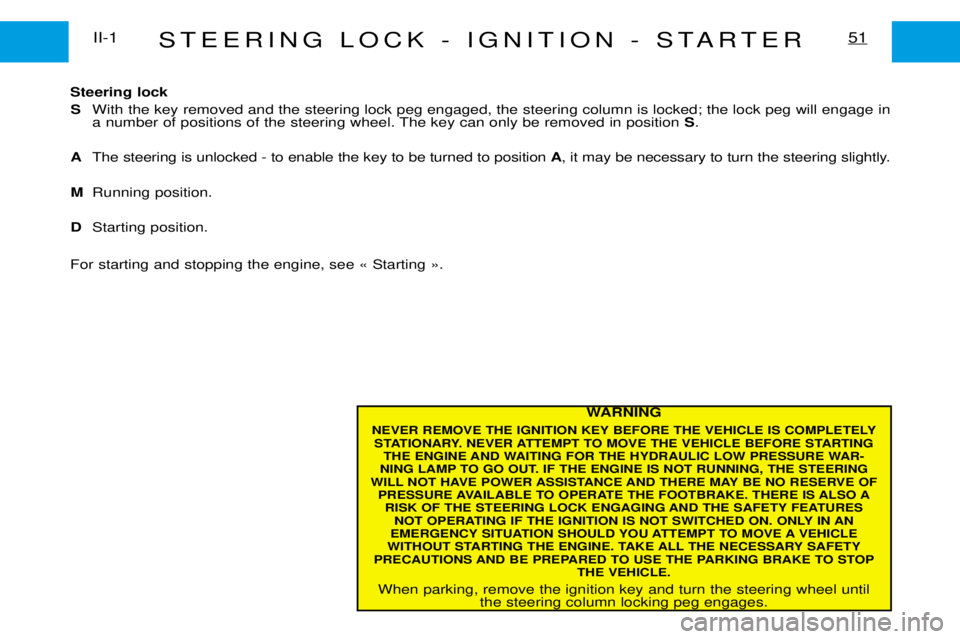Page 2 of 149
REMOTE CONTROL5I-1
Do not throw away used batteries.
Return them to a member of the dealer
network or an authorised collection point (photo shops, etc...).
Changing the remote control battery Unclip to gain access to the batteries.Battery: CR 1620 (3V). The remote control must be
reinitialised after changing the batteries. To do
this, switch on the ignition and operate the remote control.
To protect your vehicle against theft Before leaving your vehicle:
- Completely close all windows and do not leave objects visible inside.
- Remove the ignition key, turn the steering wheel to engage the steering lock and lock all doors.
Make a note of the key numbers, the remote control number, and your radio code on the specially provided card. Keep the card in a safe place - not in thevehicle.
Page 18 of 149
STEERING WHEEL ADJUSTMENTI-817
IMPORTANT
As a safety measure,
these manoeuvres must not be carried out when driving.
The height of the steering wheel can be adjusted.
When stationary, first adjust your seat to the most suitable position.
Unlock the steering wheel by pushing the adjustment control.Adjust the height of the steering wheel then lock it by pulling the adjustment control fully towards you. Make sure that you can see all the displays on the fascia panel.
Page 34 of 149
INSTRUMENT PANEL*33I-12
1Left hand air vent
2 Left hand loudspeaker (Tweeter)
3 Cruise control switch
4 Controls for: ¥ Horn¥ Lighting¥ Direction indicators¥ Front foglamps¥ Fog lamps
5 Instrument panel
6 Radio control on steering wheel
7 Controls for:¥ Windscreen wiper¥ Windscreen wash¥ Rear screen wiper
8 Centre air vents
9 Radio housing or oddments pocket
10 Electronic key indicator lamp 11
Passenger Airbag*
12 Right hand loudspeaker
(Tweeter)
13 Right hand air vent
14 Glovebox
15 Controls for:
¥ Air conditioning or heating/
air distribution
16 Front ashtray with cigar lighter
17 Gear lever
18 Controls for:
¥ Air conditioning¥ Hazard warning lamps¥ Rear screen demister
19 Steering lock and ignition switch
20 Fuse box access
21 Driver's airbag 22
Steering column adjustment lever
23 Cruise control lever
24 Controls for:
¥ Adjusting the headlamps¥ Dashboard lighting rheostat
25 Oddments pocket
26 Bonnet release lever
* According to model or country
Page 44 of 149
SIGNALLING*41I-14
Horn Press the end of the stalk. Headlamp flash Pull the stalk towards you to flash headlamps.
The headlamp flash operates even with the ignition off. Direction indicators Left: move the stalk downwards.Right: move the stalk upwards.
Movement of the steering wheel returns the stalk to the off position automati-
cally. Hazard warning lamps
Operates the direction indicators simultaneously.
Use only in case of danger, emergency stop or in hazardous conditions.
Also operates with the ignition off.The direction indicators will not work when the hazard warning lamps are in use.
* According to model or country
Protection fuses under the dashboardF7 - F26 - F30Protection fuses under the dashboardF4 - F9 - F18 - F19
(under the bonnet)
F3 - F4 - F7 - F8 (with ABS)
F2 - F3 - F12 - F13 (without ABS)
Page 64 of 149
STEERING LOCK - IGNITION - STARTERII-1
50
¥ S : Steering lock
To free the steering, turn the steering wheel slightly at the same time as tur- ning the key; avoid using undue force.
¥ A : Accessories
Allows certain electrical accessories to be used. The battery charge warning lamp illuminates.
¥ M : Ignition The following warning lamps should come on: battery charge, handbrake, oil
pressure, engine coolant temperature According to the specific version of
vehicle, the following warning lamps should also come on: Stop, ABS, Engineautodiagnostic, Preheating (Diesel), Front airbag. If one of these lamps fails to light, it could indicate a fault in the system concerned. ¥ D : Starter Release the key as soon as the engine has started. Never operate with the engine running.
These warning lamps are tested with the ignition key in the ignition on position.
Page 65 of 149

STEERING LOCK - IGNITION - STARTER51II-1
WARNING
NEVER REMOVE THE IGNITION KEY BEFORE THE VEHICLE IS COMPLETELY STATIONARY. NEVER ATTEMPT TO MOVE THE VEHICLE BEFORE STARTING THE ENGINE AND WAITING FOR THE HYDRAULIC LOW PRESSURE WAR-
NING LAMP TO GO OUT. IF THE ENGINE IS NOT RUNNING, THE STEERING
WILL NOT HAVE POWER ASSISTANCE AND THERE MAY BE NO RESERVE OF PRESSURE AVAILABLE TO OPERATE THE FOOTBRAKE. THERE IS ALSO ARISK OF THE STEERING LOCK ENGAGING AND THE SAFETY FEATURES NOT OPERATING IF THE IGNITION IS NOT SWITCHED ON. ONLY IN AN
EMERGENCY SITUATION SHOULD YOU ATTEMPT TO MOVE A VEHICLE
WITHOUT STARTING THE ENGINE. TAKE ALL THE NECESSARY SAFETY
PRECAUTIONS AND BE PREPARED TO USE THE PARKING BRAKE TO STOP THE VEHICLE.
When parking, remove the ignition key and turn the steering wheel until the steering column locking peg engages.
Steering lock
S With the key removed and the steering lock peg engaged, the steering column is locked; the lock peg will engage in
a number of positions of the steering wheel. The key can only be removed in position S.
A The steering is unlocked - to enable the key to be turned to position A, it may be necessary to turn the steering slightly.
M Running position.
D Starting position.
For starting and stopping the engine, see Ç Starting È.
Page 69 of 149

BRAKES55II-4
ABS - Anti-lock Braking System* This system improves vehicle safety by preventing the wheels from locking under emergency braking or when
braking on surfaces offering poor adhesion.
It thus also allows control of the steering to be retained. The operation of the various electronic components of the system is continuously monitored, both before and during your
journey. On switching on the ignition, the ABS lamp will light for approximately two seconds. If it stays on or lights when
driving, the ABS computer has detected a fault and has disconnected the ABS system. If the lamp lights whilst driving, it
again indicates that a fault has been detected and that the ABS system is inactive. In both situations, the normal braking
system is not affected and will continue to function as a conventional braking system without ABS. Nevertheless, to re-
establish the full safety features of the ABS system, It is recommended that the vehicle be examined by a dealer as soonas possible.
On slippery roads (loose stones, snow, ice, etc.), it is imperative to drive with caution.
* According to model or country
Protection fuses under the dashboardF12
(under the bonnet)
MF4 (with ABS)
Page 130 of 149
TOWING - LIFTINGV- 6
110
BEWARE
If the engine is not running,
the steering and braking systems will not be power-assisted.
Towing with the front or rear wheels lifted Use special towing equipment with a rigid bar and straps.Attach the hooks to each of the suspension arms.
Take the necessary precautions to protect the bumper and the front or rear of the vehicle.
NEVER TOW THE VEHICLE WITH THE FRONT OR REAR ENDS LIFTED AND THE WHEELS HANGING FREE. Towing with all wheels on theground
Towing rings are situated at the front and rear of the vehicle.
To prevent the steering from loc- king, the ignition key must be inposition "A". Use a bar with hooks to attach to the rings. Advice In exceptional circumstances, it is permitted to tow the vehicle
at low
speed over a short distance (in
accordance with the local legisla-tion in force). In all other cases, the vehicle must be transported by a trans-
porter.